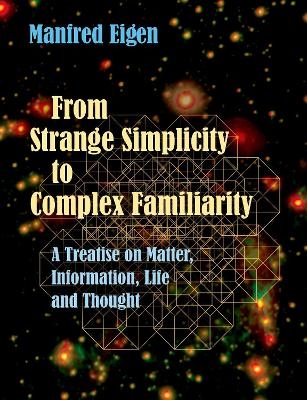
From Strange Simplicity to Complex Familiarity
A Treatise on Matter, Information, Life and Thought
Seiten
2019
Oxford University Press (Verlag)
978-0-19-884194-4 (ISBN)
Oxford University Press (Verlag)
978-0-19-884194-4 (ISBN)
This book presents a vivid argument for the almost lost idea of a unity of all natural sciences. This unity engenders the "complex familiarity" of the world in which we live and which can be described in "strangely simple" theoretical terms, leading to surprising new insights into the mysterious phenomenon of life.
This book presents a vivid argument for the almost lost idea of a unity of all natural sciences. It starts with the "strange" physics of matter, including particle physics, atomic physics and quantum mechanics, cosmology, relativity and their consequences (Chapter I), and it continues by describing the properties of material systems that are best understood by statistical and phase-space concepts (Chapter II). These lead to entropy and to the classical picture of quantitative information, initially devoid of value and meaning (Chapter III). Finally, "information space" and dynamics within it are introduced as a basis for semantics (Chapter IV), leading to an exploration of life and thought as new problems in physics (Chapter V).
Dynamic equations - again of a strange (but very general) nature - bring about the complex familiarity of the world we live in. Surprising new results in the life sciences open our eyes to the richness of physical thought, and they show us what can and what cannot be explained by a Darwinian approach. The abstract physical approach is applicable to the origins of life, of meaningful information and even of our universe.
This book presents a vivid argument for the almost lost idea of a unity of all natural sciences. It starts with the "strange" physics of matter, including particle physics, atomic physics and quantum mechanics, cosmology, relativity and their consequences (Chapter I), and it continues by describing the properties of material systems that are best understood by statistical and phase-space concepts (Chapter II). These lead to entropy and to the classical picture of quantitative information, initially devoid of value and meaning (Chapter III). Finally, "information space" and dynamics within it are introduced as a basis for semantics (Chapter IV), leading to an exploration of life and thought as new problems in physics (Chapter V).
Dynamic equations - again of a strange (but very general) nature - bring about the complex familiarity of the world we live in. Surprising new results in the life sciences open our eyes to the richness of physical thought, and they show us what can and what cannot be explained by a Darwinian approach. The abstract physical approach is applicable to the origins of life, of meaningful information and even of our universe.
Manfred Eigen, Max-Planck-Institute for Biophysical Chemistry, Gottingen, Germany
1: Matter and Energy
2: Energy and Entropy
3: Entropy and Information
4: Information and Complexity
5: Complexity and Self-Organisation
Appendix to Chapter 1
Appendix to Chapter 2
Appendix to Chapter 3
Appendix to Chapter 4
Appendix to Chapter 5
| Erscheinungsdatum | 12.06.2019 |
|---|---|
| Zusatzinfo | 50 grayscale and 179 color line figures, and 33 color half-tones |
| Verlagsort | Oxford |
| Sprache | englisch |
| Maße | 189 x 248 mm |
| Gewicht | 1572 g |
| Themenwelt | Naturwissenschaften ► Physik / Astronomie ► Astronomie / Astrophysik |
| Naturwissenschaften ► Physik / Astronomie ► Festkörperphysik | |
| Naturwissenschaften ► Physik / Astronomie ► Thermodynamik | |
| ISBN-10 | 0-19-884194-9 / 0198841949 |
| ISBN-13 | 978-0-19-884194-4 / 9780198841944 |
| Zustand | Neuware |
| Informationen gemäß Produktsicherheitsverordnung (GPSR) | |
| Haben Sie eine Frage zum Produkt? |
Mehr entdecken
aus dem Bereich
aus dem Bereich
Schulbuch Klassen 7/8 (G9)
Buch | Hardcover (2015)
Klett (Verlag)
31,50 €


